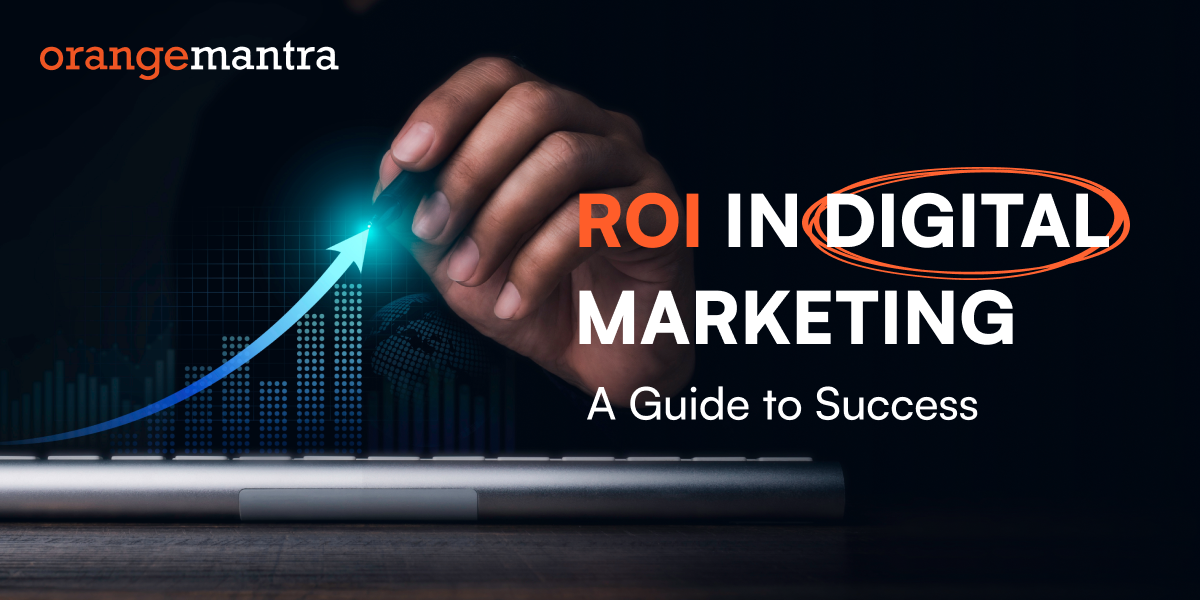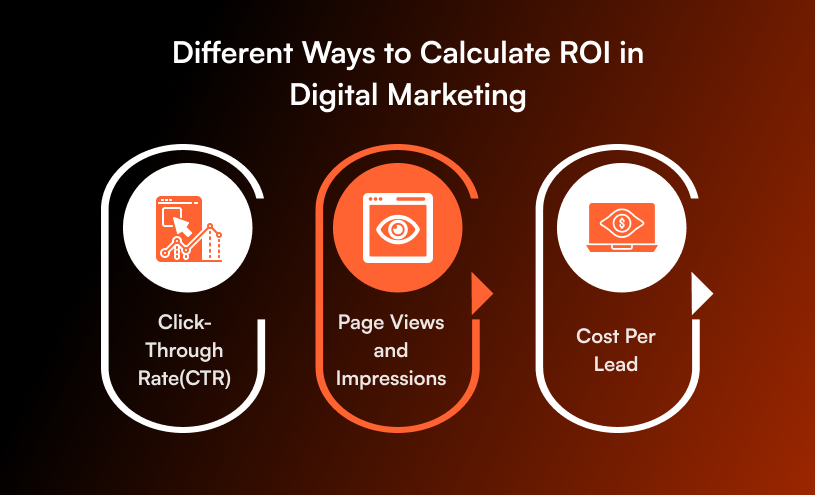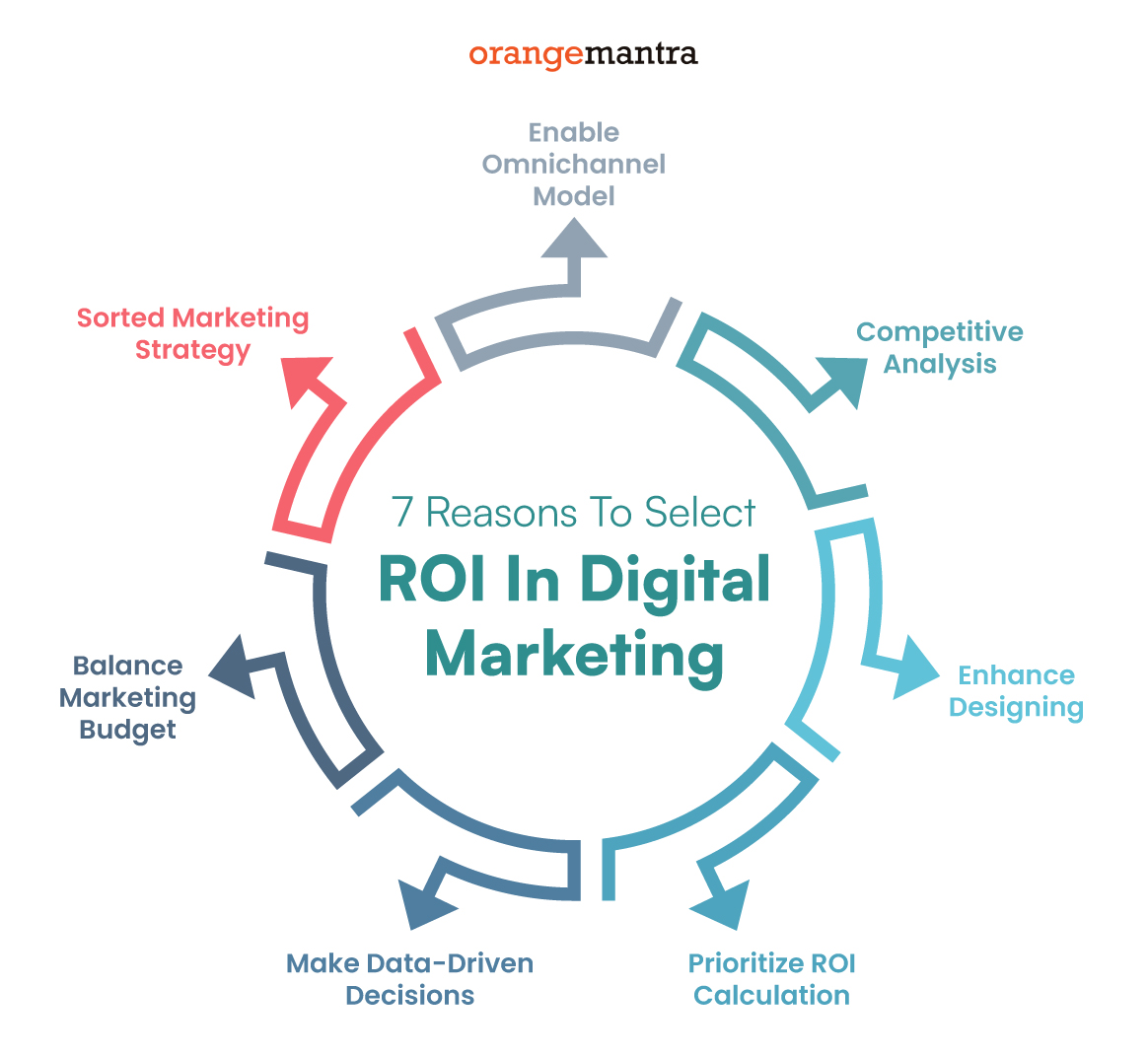
What is ROI in Digital Marketing
Nowadays, digital marketing is one of the most potent forms of promotion if you are trying to launch and promote your service or product. Through digital marketing, companies promote their business goal, the characteristics, and the usability of their products and services through different forms of content, and running campaigns on various social media platforms.
Calculating the Return on Investment (ROI) for your digital marketing business is important. The ROI in digital marketing formula is the latest concept that marketers are trying to incorporate into their businesses.
If the calculation is done accurately, you will be able to generate an equal number of business deals and leads. ROI in digital marketing highlights the exact number of how campaigns perform in terms of generating business leads on the total number of investments.
Also, ROI in digital marketing helps in measuring the total amount of investment and cost of a marketing campaign run in a month. Well, whatever digital marketing campaign you run, return on investment helps in calculating the overall effectiveness of the ads on different social media platforms.
These campaigns can be pay-per-click(PPC) ads or search engine optimization for measuring the rank of your website. This blog sheds light on the importance of ROI in digital marketing and its core significance of it and the process of calculating them while you are promoting your service on different social channels.
Table of Contents
What is ROI in Digital Marketing?
ROI in digital marketing stands for Return on Investment and is a critical metric that measures the profitability of your marketing efforts. It tells you whether the money you’re spending on digital campaigns, such as paid ads, SEO, email marketing, or social media, is generating a return in terms of sales, leads, or other desired actions.
Key Pointers:
- ROI is a performance indicator that helps marketers evaluate which strategies are effective.
- High ROI means more value is being generated from less investment.
- It allows data-driven decision-making, helping businesses allocate budgets more efficiently.
- ROI varies by channel (SEO, PPC, email, etc.), so tracking each channel separately is crucial.
- Non-monetary ROI, like brand awareness or engagement, is also important but harder to quantify.
What is the Significance of Measuring Digital Marketing ROI?
In which so ever business you are in, the calculation of ROI in the digital marketing department is the most crucial part. Especially, if you are in the eCommerce business, probably you cannot bypass the relevance of measuring the amount of return on investment.
Also, while you are investing a certain amount of money in campaigns, you need to check and analyze if that is worth investing in. Which campaigns are successfully running and which are lagging behind; this is also a matter of analysis. Once you are convinced of the quality performance of any campaign, you will try to invest in those campaigns in the future.
The two most important approaches to digital marketing campaigns are Adwards and running PPC marketing services. So, if you want to boost your ROI, the best option is to concentrate on increasing your organic traffic. Content marketing Services are one of the major parts of boosting your digital marketing strategy through generating well-structured blogs with the inclusion of long-tail keywords.
There are many other parameters to measure ROI in digital marketing, which is another matter of discussion. Now, let’s understand how ROI is measured in the digital marketing field.
How to Calculate ROI in Digital Marketing?
Calculating Return on Investment (ROI) in digital marketing is important for measuring the effectiveness of your campaigns. ROI lets you determine whether your marketing efforts are generating profits or draining your budget. A well-calculated ROI gives you insights into what’s working, what isn’t, and where you should allocate resources.
Basic ROI Formula:
ROI = (Net Profit from Marketing – Marketing Cost) / Marketing Cost × 100
This formula gives you a percentage that represents the return on every dollar spent. For example, if you spent $1,000 on a campaign and earned $2,500 in revenue with $500 in costs, your net profit is $2,000. That makes your ROI:
($2,000 / $1,000) × 100 = 200%
Key Steps to Calculate ROI:
1. Track All Campaign Costs
Include ad spend, tools, content creation, agency fees, influencer payments, and internal resources to get an accurate cost figure.
2. Define Clear Goals & KPIs
Set measurable goals like lead generation, website traffic, sales, or customer acquisition to quantify returns effectively.
3. Use Attribution Models
Understand which channels or touchpoints contribute most to conversions using first-touch, last-touch, or multi-touch attribution.
4. Consider Customer Lifetime Value (CLV)
For long-term campaigns, include CLV to reflect the total value a customer brings, not just the initial sale.
5. Analyze & Adjust
Use the ROI insights to scale what’s working and refine or eliminate underperforming channels or strategies.
Different Ways of Calculating ROI in Digital Marketing
To evaluate the effectiveness of your ad campaign, there are different parameters to mention. Let’s take a look at the following pointers and how it is being calculated by digital marketing companies.
1. Click-Through Rate(CTR)
This is the measuring factor to understand how much attention is gained by your audience. Every business has the goal to improve its revenue. To do that companies tend to promote their products and services through digital marketing tools. CTA refers to the number of clicks on an advertisement and the number of social posts seen on the website. For this, you need to identify what type of post mostly engages the maximum number of users.
2. Page Views and Impressions
It is important to have a clear idea about the products and services you are offering. The concept of brand awareness comes here. Impressions and page views are directly connected to the brand awareness of your company. It is like the total number of people who are visiting your website, the more they will get to know about your service offerings.
3. Cost Per Lead
Return on investment is more accurately measured through different cost per lead. The definition of CPL is the total cost needed to get the required engagement of new users. ROI can vary depending on CPL.
There are many other parameters to measure ROI in digital marketing services. The above-mentioned ways will guide you understand the basic crux of calculating ROI for your business.
Essential Ways to Improve Digital Marketing ROI
Though there are several parameters to calculate ROI in digital marketing, it is also important to know the aspects of improving it. So, if you are wondering how to improve digital marketing ROI, the following are some of the basic pointers you can count on.
a. Stick to Your Already Set Goals
A proper digital marketing strategy can give you a different dimension of business growth. The strategy is directly connected to any kind of a company’s already set business goal. At the very first step, you need to stay focused on your report of digital marketing KPIs, understand the budget constraints, and further the scope of achieving your goal.
b. Identify the Channels Which Fit Best For Your Business
It is always better to stay focused on a limited number of channels for expecting a better version of ROI. First- look closely, and analyze the channels like PPC, email, Search Engine Marketing Services, or SEO Services that fit best for your organization. Only then you can decide upon the marketing budget for the purpose of maximizing your ROI.
c. Test your level of ROI
You can judge how your are campaigns going but that is only by testing them. You always need to upgrade your campaign and run a test, if the campaign is going in the right direction or not.
Top Reasons to Select ROI in Digital Marketing
1. Targeting Data-Driven Decisions
For any internal organizational decisions, if the result is data-driven, then it will be more impactful in terms of reaching your business goal. Now, the metrics of ROI in digital marketing guide you in deriving more data-driven insights for your company.
Also, the data-driven ROI metrics will help you reshape your strategies which will help you reach the next level of operational work. If you make decisions that are specifically supported by data, it will further reshape your strategies in a better way.
2. Balance in Marketing Budget
It is always a good approach to measure your overall marketing budget beforehand. If you are thinking that you will be calculating the budget after preparing the marketing strategy, you are going in the wrong direction. You always need to preplan your budget measuring approx ROI in digital marketing. Furthermore, calculating ROI will allow you to take insight into your next month’s marketing budget.
So, be extra cautious about the calculation of the ROI budget. If your previously made budget plan becomes successful, there will be more room for reinvesting your money in your next campaign plan. It is always important to take a close look at your previous marketing results.
3. Sorted Marketing Strategy
Streamlining your company’s digital marketing strategy is a tough task to handle. You need to be more careful about planning your budget as it can affect your future planning. In case you are in the process of upholding the PPC campaign and anything positive is not coming up, then there is no point of strategic planning in person. ROI calculation can help you derive a plan where you can include some other activities. Here in this case, while calculating ROI, you need to carefully design campaign content that helps you in reaching your goal for the campaign.
4. Try to keep aside multiple omnichannels
If you are into any business, digital marketing will allow you to be aware of different channels where you promote your products and services. In reverse, you will also get to know about other businesses and services. This will further help you in building brand awareness. All you need to do is start a calculative measure of your ROI.
Understanding the space where you can invest is also important. ROI in digital marketing leverages getting a clear idea about the same. It is important to make strategies for digital marketing campaigns only on one or two channels. Running campaigns on multiple omni channels can confuse customers.
5. Leverages you with competitor analysis
It is always important to keep track of your competitor and analyze their marketing activities and behavior. And ROI in digital marketing does that for you to work on your strategic decision. It is a continuous learning process to perform competitor analysis which will eventually drive overall growth in the business.
Still, companies fail to perform the same due to a lack of understanding about the same. Some companies prefer to build a separate team for this research and analysis part for their brand’s competitors. On the basis of this analysis, companies will be able to calculate their ROI for the current month and for future speculations as well.
6. Creative designing largely depends on the ROI calculation
While strategizing your digital marketing, it is important to plan carefully your creatives. The nature of your creative formation will largely depend on the final calculation of ROI. Now the creative designing team should be so proficient that the company does need to rely on external professionals.
The creative team should feel proud of the final product. Also when the creative in the form of a campaign will run, the engagement of that ads should be analyzed. This will further help the digital marketing department plan for the next course of action for the campaign and calculate ROI accordingly.
7. Prioritizing the goal for calculating ROI
The very first step of your digital marketing planning is understanding the need for calculating ROI. It is important to prepare your team for understanding the need for measuring ROI. When you are making a strategy for your return on investment, you should acknowledge the fact that is equivalent to the return on investment you decided earlier.
Concluding Thoughts
The above-mentioned factors will help you understand the reasons behind calculating ROI. Apart from these, there are many other factors for measuring it. You need to be aware of planning the entire ROI much before you actually invest. The success of an organization depends on several factors.
If you are running your business, you need to first think of your digital marketing strategy and proceed with measuring ROI in the digital marketing services that you are offering. It is not an easy task for you to do that but making it a practice will ultimately help you in the overall growth of your business.
FAQs
1. What is ROI in digital marketing?
ROI (Return on Investment) in digital marketing measures the profitability of your marketing efforts. It compares the revenue generated from digital campaigns to the cost invested in those efforts. A positive ROI indicates that your campaigns are generating more revenue than they cost to run.
2. What is a good ROI for digital marketing?
A good ROI varies by industry and channel, but a 3:1 ratio (i.e., $3 earned for every $1 spent) is often considered solid. However, for high-margin businesses, acceptable ROI can be lower, while eCommerce or SaaS companies may aim for higher multiples.
3. Which digital marketing channels offer the highest ROI?
Typically, email marketing, SEO services, and referral marketing offer the highest ROI due to lower costs and long-term value. Paid channels like PPC services can also deliver strong ROI when properly optimized.
4. Why is ROI important in digital marketing?
ROI is crucial because it helps you understand which strategies generate the most profit. It enables better budget allocation, improves decision-making, and ensures accountability for marketing investments.
5. How can businesses improve digital marketing ROI?
To improve ROI:
- Target the right audience
- Use data-driven strategies
- Optimize landing pages and CTAs
- Leverage SEO and PPC services efficiently
- Test and refine campaigns continuously
6. What metrics are used to measure digital marketing ROI?
Key metrics include:
- Conversion rate
- Cost per lead (CPL)
- Customer acquisition cost (CAC)
- Customer lifetime value (CLTV)
- Return on ad spend (ROAS)
- Organic traffic growth
7. What tools are best for tracking ROI in digital marketing?
Popular tools include:
- Google Analytics 4 (GA4)
- HubSpot
- SEMrush or Ahrefs (for SEO ROI)
- Google Ads / Microsoft Ads
- Marketing automation platforms (like Marketo or ActiveCampaign)
8. What are the common mistakes that hurt digital marketing ROI?
-
Not defining clear goals or KPIs
-
Targeting the wrong audience
-
Under-optimizing landing pages
-
Ignoring SEO or content strategy
-
Failing to track performance properly






